Lest we forget the casualties of a revolution
Afia Jahin
August 5, 2024 is two months behind us. That’s a much longer time than between citizens demanding the authoritarian Hasina step down and her actually fleeing. Yet, for many people, July-August 2024 will always shadow their present. Even by the end of August, pretty much all the beds of the ground floor casualty wards at the capital’s National Institute of Traumatology and Orthopaedic Rehabilitation (NITOR) were occupied by those injured during the student-led movement. The wards at the National Institute of Ophthalmology & Hospital (NIOH), too, were filled with those who had received severe injuries to their eye(s) during the movement.
In speaking to these patients and their families, getting to know their injuries and woes, the elephant in the room was the fact that none of the shattered bones or blinded eyes or missing limbs were “regular injuries”. All were sanctioned and carried out by those then in charge of protecting Bangladesh’s citizens.
Muhammad Rumman, a 17-year-old survivor who used to work at a biriyani restaurant in Mohammadpur’s Town Hall, went to join the protest during his breaks. “On July 19, at around 8:30pm, we were throwing bricks when the streetlights went out and the police, alongside Chhatra League, began releasing tear gas and shooting randomly. A friend of mine managed to get me on a rickshaw and brought me to the nearby Shaheed Suhrawardy Medical College and Hospital. After they bandaged me up, I was told to come to NITOR. I have been on this bed since my first operation on July 20. Now they have recommended for me to be discharged as staying here longer could cause an infection.”
The doctor has reassured Rumman that he would be okay. “But I would have to have this metal frame on for six months to a year, and wear a cast for another six. Because of how the bullet shattered my knee, I can’t even sit up properly. So we have to rent an ambulance to come here each month for the checkup, which costs Tk 10,000 both ways.” Rumman would be able to walk but won’t be able to carry heavy loads, which disqualifies him for many suitable jobs. “My father is a day labourer and the two of us are the earners in our family of five. I earned about Tk 6,000 to Tk 7,000 per month, all of which went to the family.”
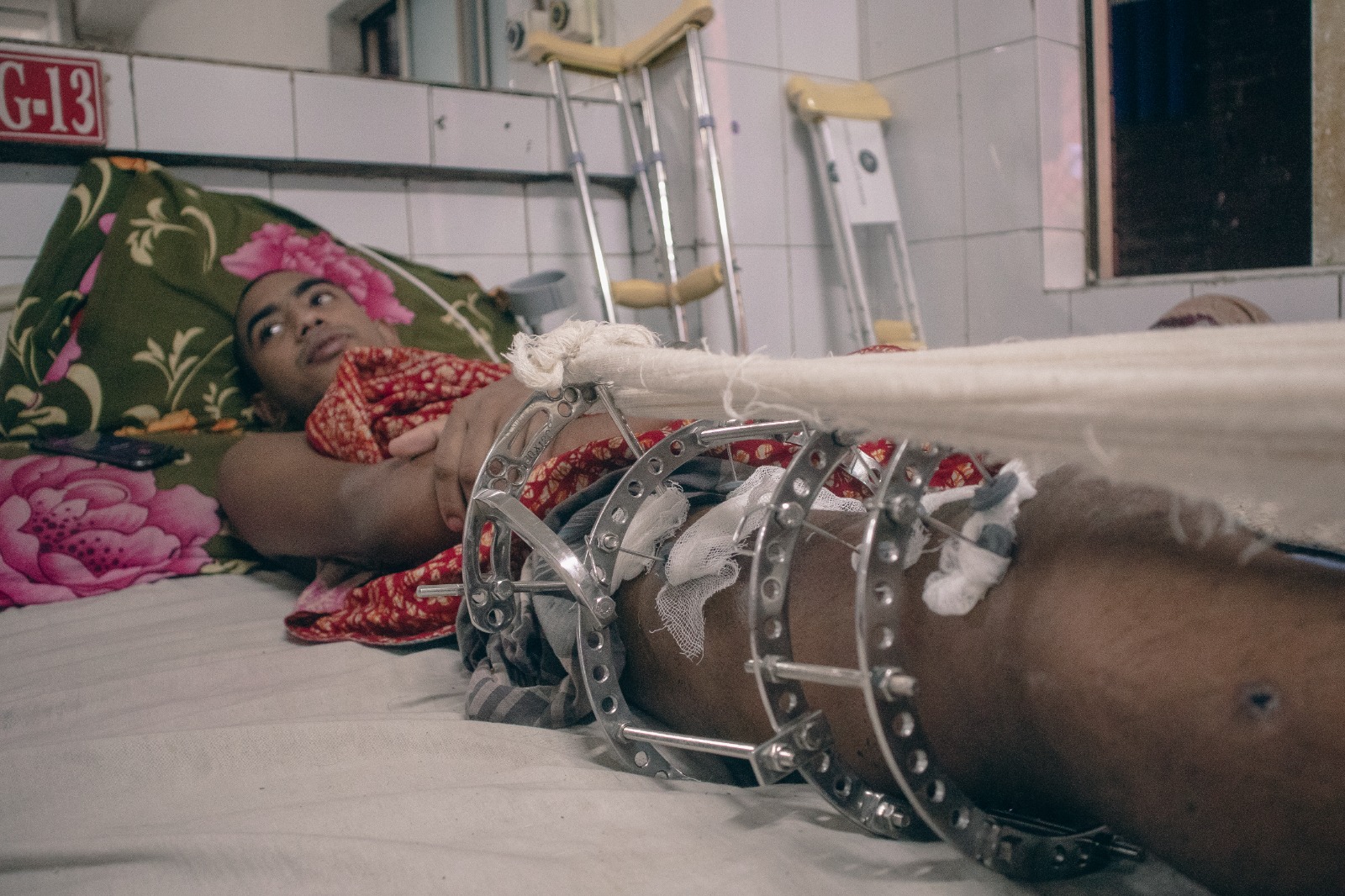
Rumman would be able to walk but won’t be able to carry heavy loads, which disqualifies him for many suitable jobs
A few beds away, Md Dulal Hossain, a wall painter by profession, has no idea when he might be able to leave the hospital. “On August 5, we had no work due to the situation at the time. And there was no expectation of any bullets being shot that day. But during the victory celebrations, people threw bricks at the nearby police station. And it was both the police and the Chhatra League who came out in retaliation, armed. A single bullet came in through the right side of my waist and exited out the left side, fragmenting my hip joint and damaging my digestive tract. Initially, I was taken to the Uttara Lake View Specialized Hospital. The operation there saved me, but the cost became unbearable. I couldn’t even leave to get admitted to a public hospital because the bills there were unpaid. So my sister and her husband arranged the amount in loans.”
Dulal’s sister conveys to us anxiously, “We aren’t sure when my brother will be able to get discharged. There is no one to look after him right now but me, as his wife works in a garment factory and they also have two young children who need to be looked after. My husband runs a tea stall. I only worry about how we will be able to repay our debt.”

Looking at Dulal Hossain’s X-rays and the urine bag hanging off his bed, we could barely utter any words of hope to console his sister.
Meanwhile, the mother of young Md Shahidul Islam (who had been operated on earlier that day and was in recovery) told us how he’d ignored her pleas and joined the protests at Dhaka’s Mirpur 13 on July 19.
Shahidul received a bullet to his left hand, and a rubber bullet below his navel. “When we first came here [NITOR], he received treatment. But I took him home to Kishoreganj after some people warned me that if my son remained here, he’d be taken away by the police. He was at the Shahid Syed Nazrul Islam Medical College Hospital for 22 days, after which they recommended we come back here,”said his mother.
Once back at NITOR, the mother-son had been turned away a number of times. “We were handed some medicines and told my son could recover at home. It was only when a young man—after hearing how we had to spend a lot of money just to come here every few days—helped us to get a bed that the doctors realised how serious my son’s case was. He only has his little finger intact now. I have had to borrow around Tk 2 lakh to cover his treatment. His father died when he was 7.”
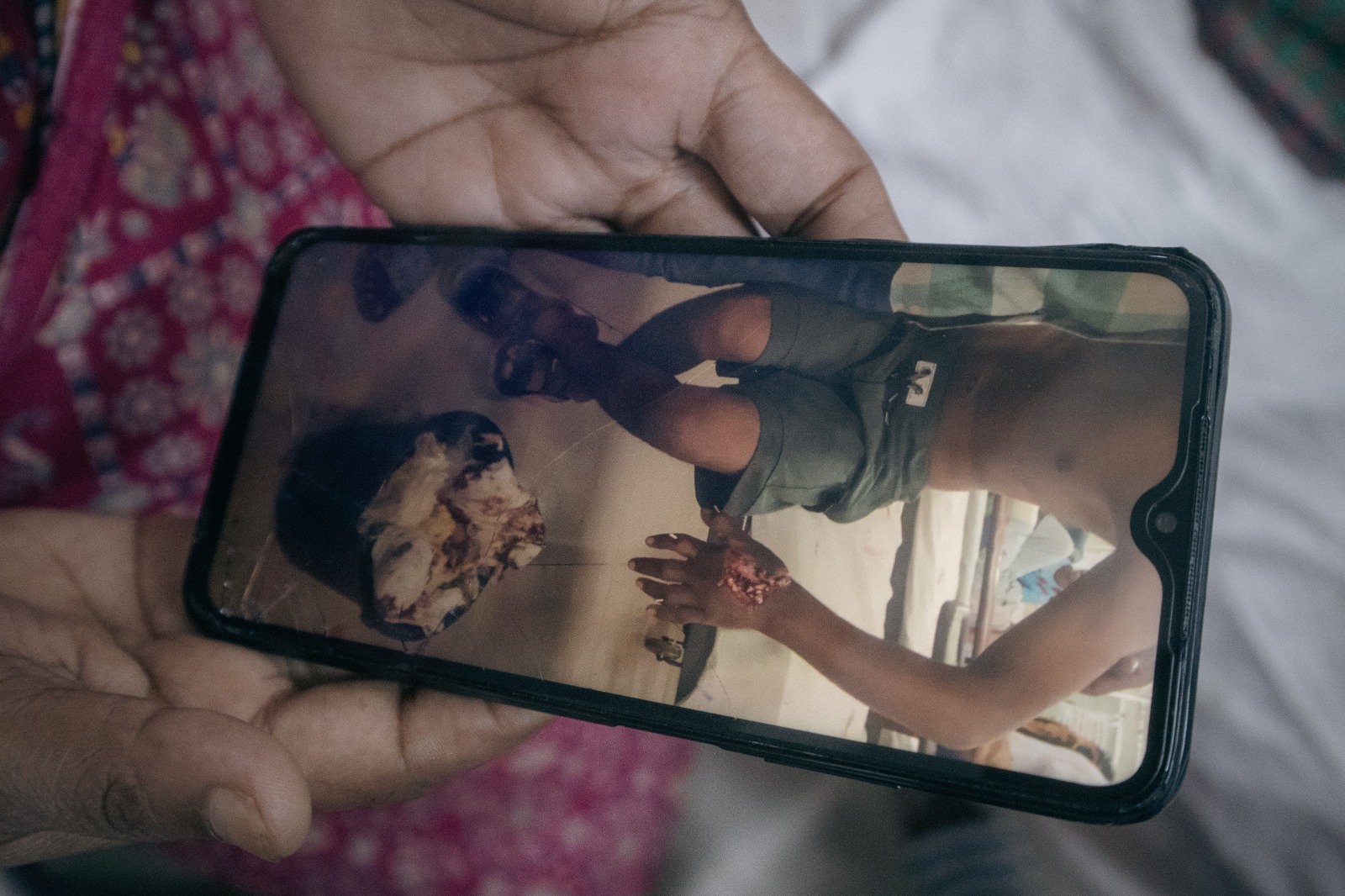
Shahidul's mother says, “When we first came here [to NITOR], he received treatment. But I took him home to Kishoreganj after some people warned me that if my son remained here, he’d be taken away by the police.”
Like many of the patients we spoke to, 35-year-old security guard Md Mostofa too had gone to join protests after the Jummah prayer on July 19. And like many of them as well, he was shot by police, to the point of long-term injury. “I have lost function of my right wrist. The doctor had said I needed an amputation. But I begged him to save my hand. I have two children, and we are poor. Without a hand, I would have no way to earn for them.” In total, Mostofa would need six operations, as determined by a body of 30 doctors at NITOR. Under the heavy bandaging around his abdomen is evidence of skin grafting, from the stomach to the wounded wrist.
“All of us, be it rickshaw pullers or security guards, took to the streets to demand Hasina’s fall. I don’t mind having been shot, hopefully the Almighty will heal me someday. But I feel extremely proud of the fact that we were able to overthrow the dictatorship. I feel I can breathe fully now.”
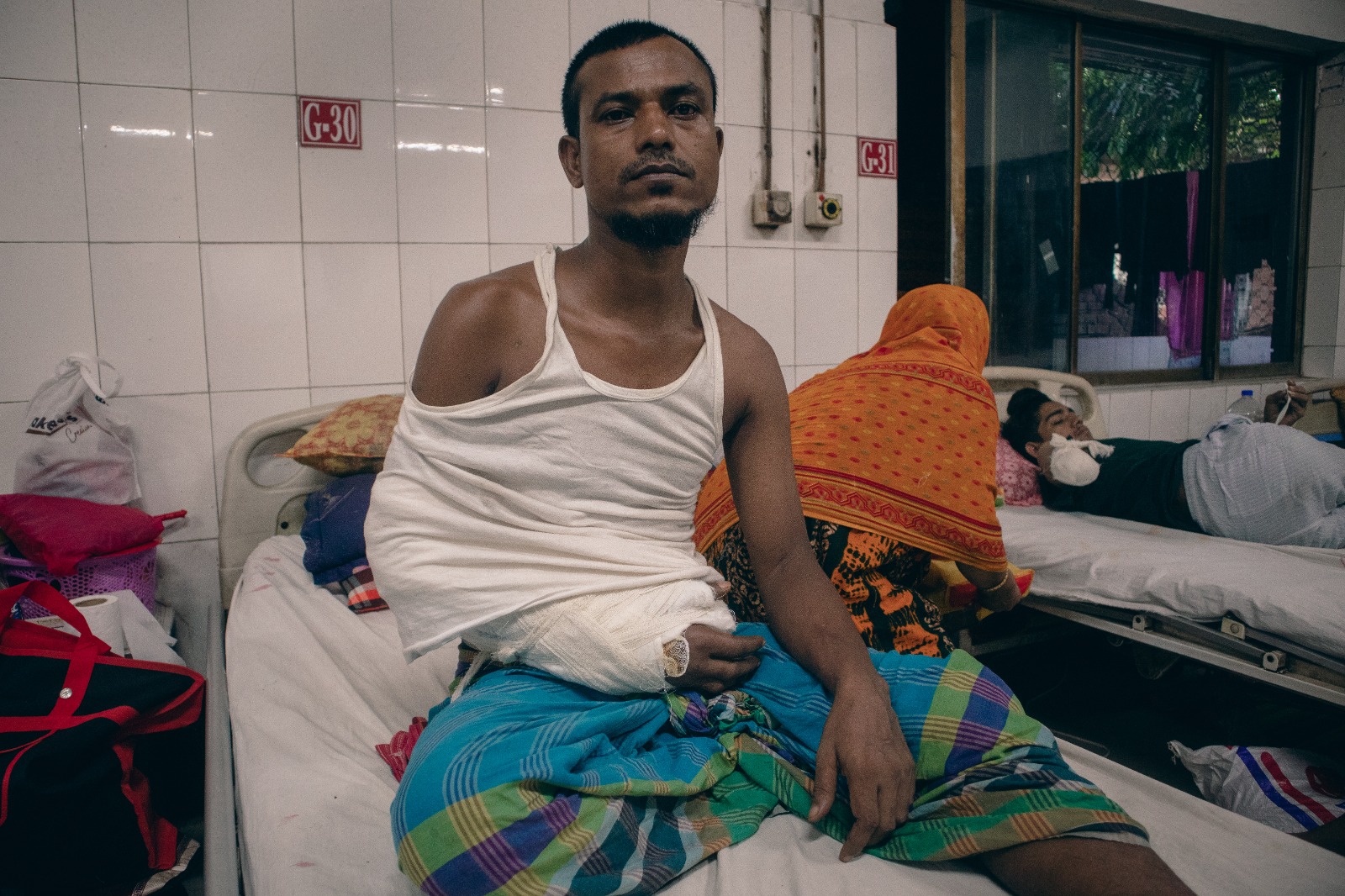
35-year-old security guard Md Mostofa
Perhaps the person who stood out the most during our visit to the two public hospitals was 22-year-old Md Emon Kabir who, despite the metal frame around his shot leg, was all smiles and zest during the latter part of our conversation.
Emon is a student at the Jashore Polytechnic Institute and has been in Dhaka for an internship. “My plan was to either do a BSc or go abroad for higher studies. Unfortunately, I got shot in my leg during the movement.”
On July 19, Emon was with a group of students consisting of those from BRAC University, East West University, and others. “We left the Jummah prayer and, as we got close to Rampura Bridge, the shooting began. The two groups we observed conducting the attack were the police and the BGB [Border Guard Bangladesh]. I saw that they were in their ‘battle’ position, on their stomachs, guns pointed. When the shooting began, we first stopped those who were throwing bricks and debris back at the police and BGB. Then, we waved our hands and shouted requests at them: ‘Uncle, please don’t shoot us.’ But we could clearly hear the slurs they were spewing in our direction. And we know they heard our pleas because our voices of desperation were certainly louder than their curses. I got shot when I was trying to pick up a person next to me who’d just been shot.”
Only the night before, on July 18, Emon tells us how he experienced unimaginable terror. “It was the night when the countrywide internet blackout began that I was in Rampura area with other protestors. I believe I witnessed the horrific extent of the law enforcement’s ability to kill people. That night, I was holding an injured brother inside an ambulance on our way to a hospital. He died in my arms. His last words to me were: ‘Bhaiya, will I live?’”
On his way home that night, Emon threw away the shirt he was wearing. After what he witnessed on the night of July 18, it was impossible for him to sit at home.
“After I was shot, one fellow protester tied up my leg using the prayer mat I was carrying. I was taken to Nagorik Hospital by rickshaw first, and then brought here [to NITOR]. I was lucky enough to be operated on within an hour of being shot. I had no money, so a fellow protester helped me out. After I got out of the OT, I saw that there wasn’t space for even a pin to be stored in this hospital; the number of patients [all having been shot] was so huge. I even saw dead bodies scattered around here and there. I’d like to escape the trauma of that. I can’t take it anymore. Whenever I remember those scenes, I feel troubled. They often shake me out of my sleep and cause a sharp pain in my leg.”
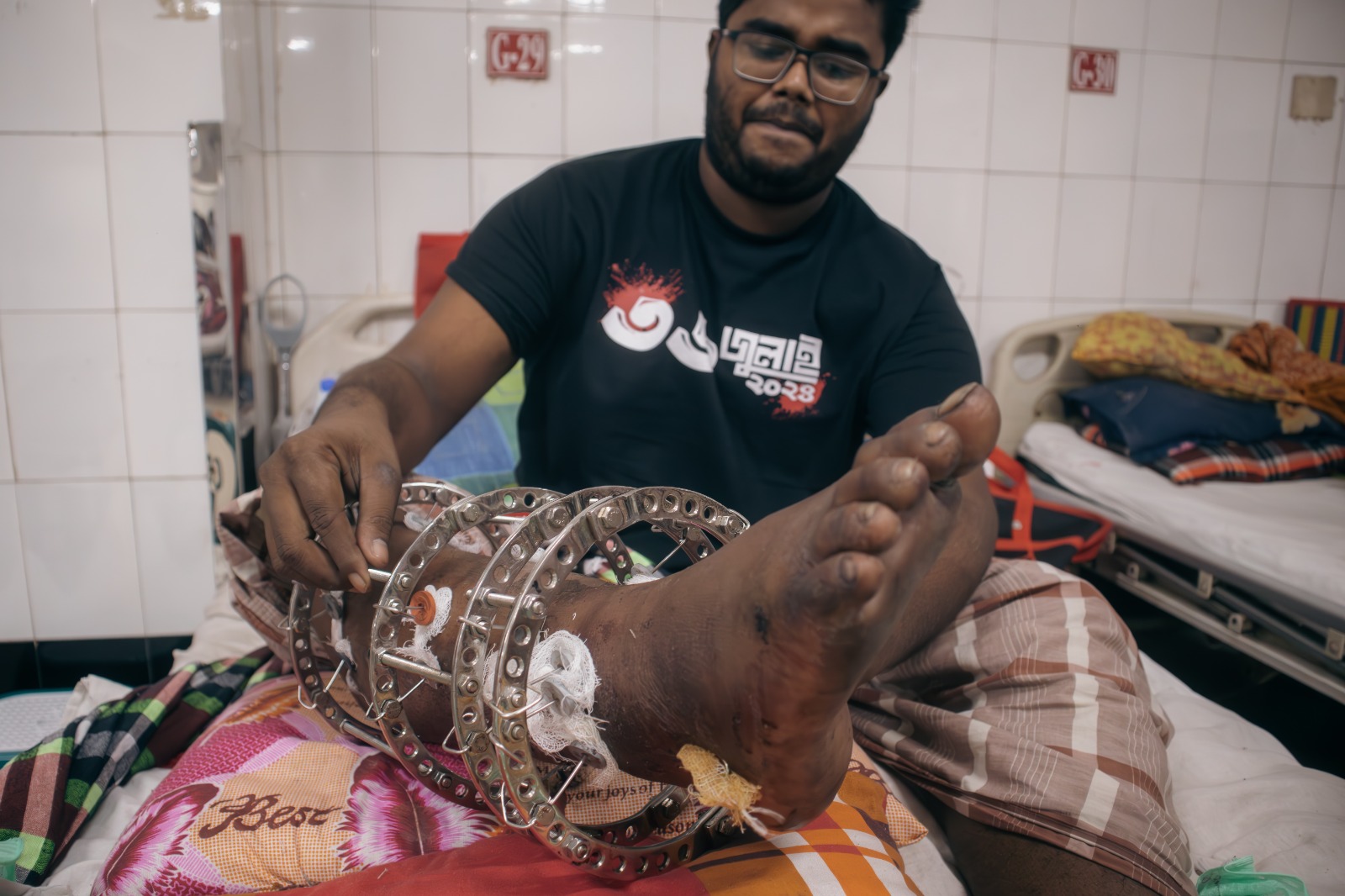
22-year-old Emon Kabir shows off his '36 July' t-shirt. Emon was shot in his leg on July 19 while trying to help the injured protestor next to him in Dhaka's Rampura area.
Emon has lost count, but he told us how, at the time of our conversation, he’d been in his bed for 37 or so days. He was curious to explore the surroundings, to breathe the outside air.
When asked about his friends, Emon tells us they visit him sometimes, but less often now. “You know how it is, people get busy with their own lives after a point. But I’m regularly texting and talking with my closest friends. They don’t talk to me like I’m a patient. If my condition wasn’t so serious, they’d probably have hogged my bed while I shifted to the floor.”
Emon’s main point of sadness is the fact that his dream of going abroad to study now seems shattered. “I’d planned to sit for my IELTS exam, but the doctor has said that I can’t put pressure on my leg anymore like I was able to before.”
He is also afraid that, if someday he is able to get the chance to fulfil his dream, authorities at a university may deem him a criminal because of his “bullet wound”, When we tried to reassure him, saying that a police clearance certificate could help him out there, Emon said, “Have never had faith in police. I’ve blocked the two police friends I had on Facebook. I also have a mama who’s in the police. He’d called me to check up on me but I said to him, ‘Police-er chakri chhere jodi kono din phone dite parish, tahole phone dibi, noyto dibi nah.’ (‘Call me if you ever leave the police force. Otherwise, don’t.’) I referred to him as ‘tui’, that’s how disgusted I am by them.”
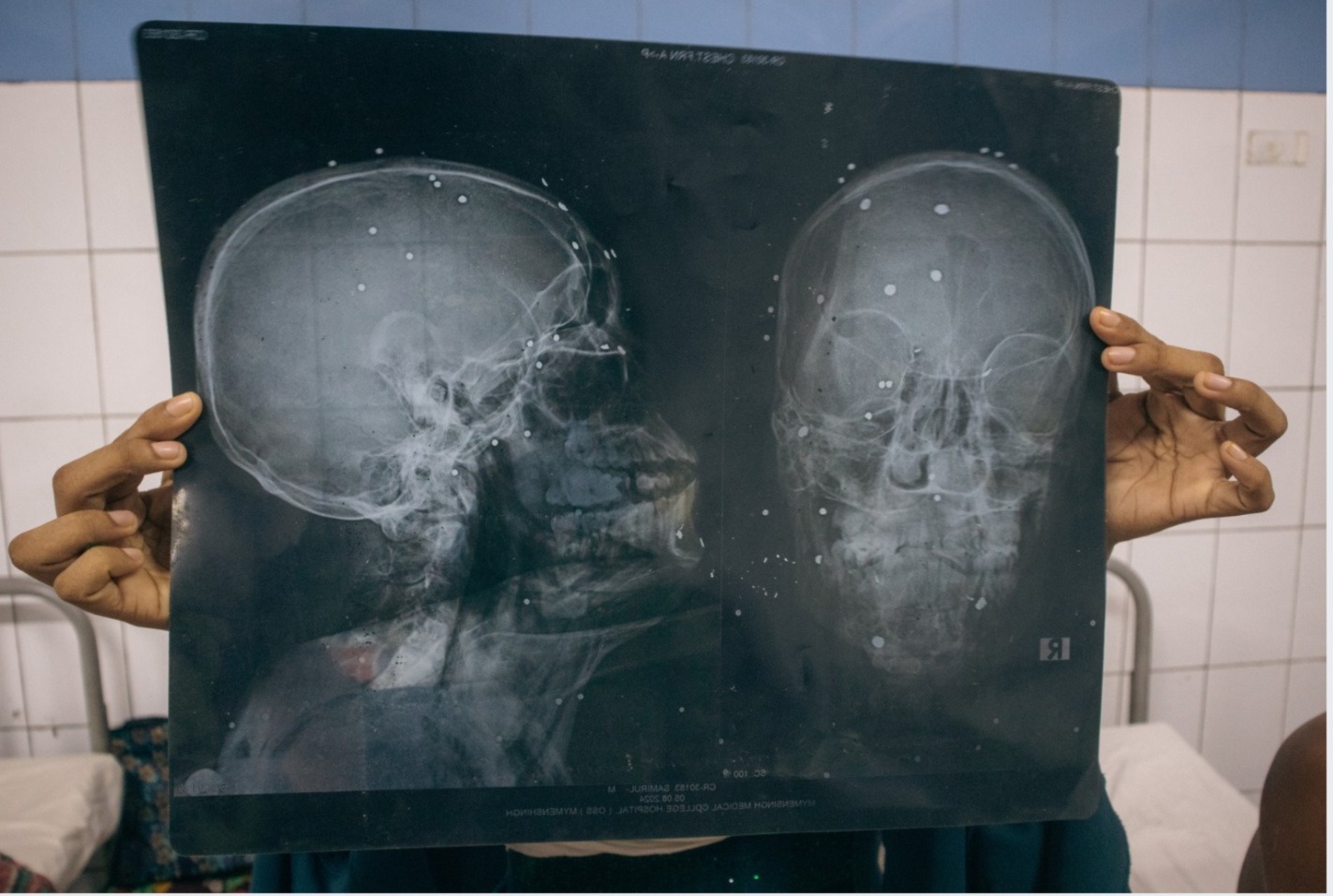
Samirul was shot with 200-250 rubber bullets on August 5.
Samirul, having had an operation earlier that day, was hunched over on his bed when his older sister, Surma, walked us to him. “My brother is an HSC examinee. We live in Gazipur. On August 5, Samirul had gone to the victory rally. When they were near the Safipur Ansar academy, people from Ansar and also BGB approached the crowd of 300-400 and invited them inside. They congratulated the rally participants on their victory and said they wanted to shake hands with them. Once inside, the situation turned as one officer closed the gate of the academy. Then, they asked the crowd to run. But they had nowhere to run to and the officers began shooting indiscriminately. My brother was shot with 200-250 rubber bullets. Three of his friends died.
“My brother fought for his life in a hospital in Mymensingh for 12 days. He could hardly breathe. We had no hope for his survival, but Allah saved him. Afterwards, we came here [National Institute of Ophthalmology & Hospital (NIOH)] to get treatment for his eye. The doctors have said that trying to get the rubber bullets out would mean taking his eye out as well. We decided against that so he could at least have the appearance of having his sight.” Surma says that her family doesn’t feel bad, as whatever her brother did was done for the betterment of the country. “Even if he had died, we’d still feel the same way. Our only point of pain is the fact that our fellow citizens, the public servants, have broken laws and killed and hurt people so ruthlessly. I know of many people in Gazipur alone who were killed and then dumped into gutters. I would ask the new government to bring these law-breakers to justice. And, of course, we want justice for the dictatorship.”
Among these tales of horror, though, is one silver lining: the relative helpfulness of the new interim government. Faruk Alam, who works with the BRT project in Tongi, but is originally from Nilphamari, felt compelled to join the protests after Abu Sayed was killed in Rangpur. The decision, however, resulted in Faruk being almost robbed of his sight. “On July 18, while protesting in the capital’s Uttara area, I was shot with rubber bullets in both of my eyes. After receiving primary treatment here on July 21, I was referred elsewhere and had to spend upwards of Tk 1 lakh at a private hospital. But on August 22, I was contacted by the Directorate General of Health Services and told that I could get my treatment done here, at NIOH. They reassured me that if I face any problems, they’d take care of it. They even offered to pay me back the Tk 1,100 I’d spent at this hospital earlier. So I came back here and am now waiting to get another surgery to see how much of the sight in my left eye can be recovered.”
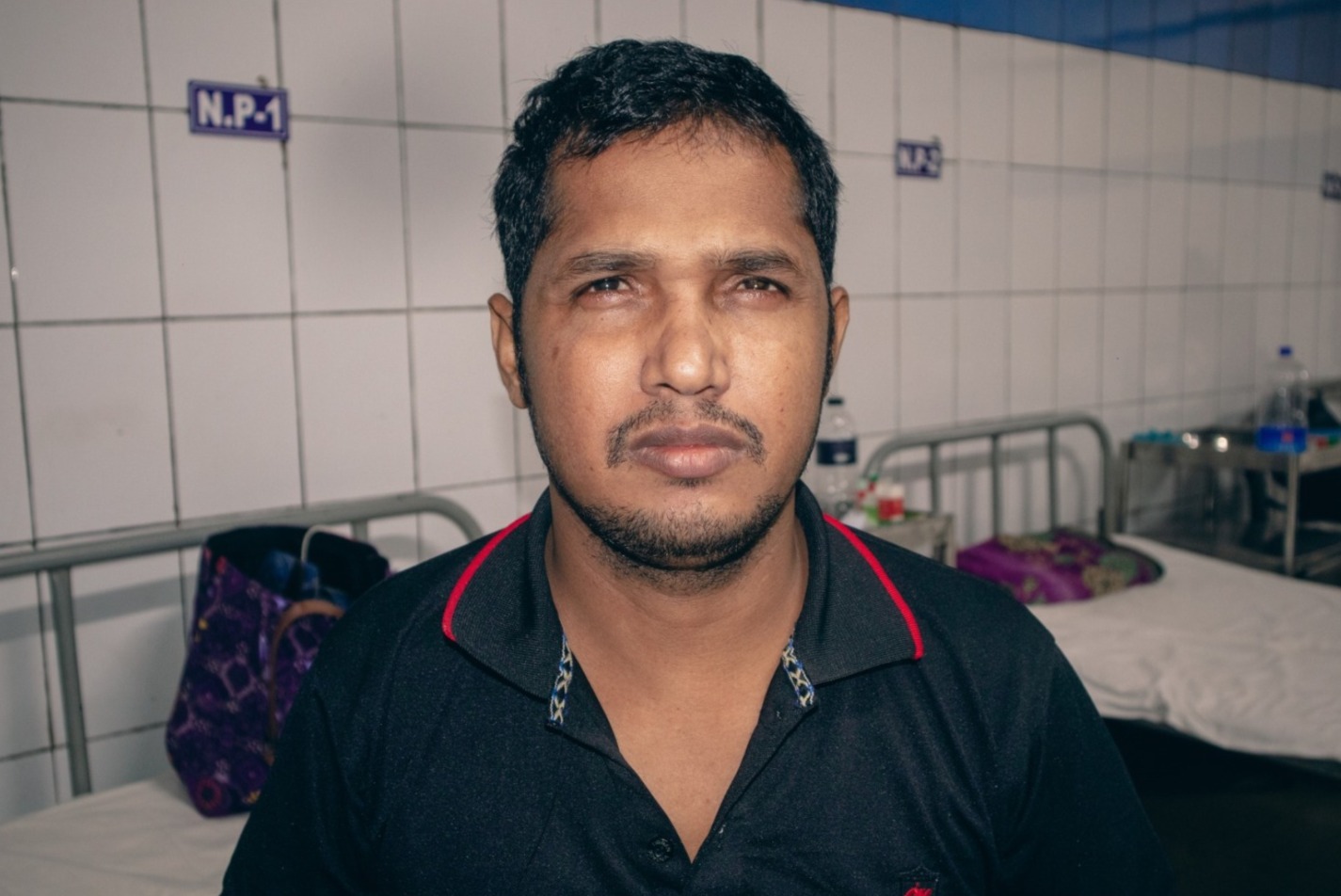
Rakibul Hasan Rocky received 62 rubber bullet wounds on August 4 at Joypurhat. He has lost sight in his right eye and will likely have blurry vision through the left one—or no vision at all.
Despite the indication that he won’t be able to see as well as before, Faruk feels satisfied that he was able to participate in the movement for his country and was able to help cause the fall of a dictatorship.
The wounds that our interviewees, and thousands of others, have been subjected to are terrible. Most of them see a dim future ahead, riddled with financial and other kinds of woes. But each of these people is owed by the new country. Even if they don’t ask for it, we owe them eternal acknowledgement and honour if only for snatching for us the freedom to finally call the fallen government every bad thing that it really was.
Afia Jahin is a writer and journalist.
All photos by Maruf Arefin Mim
Back to Homepage